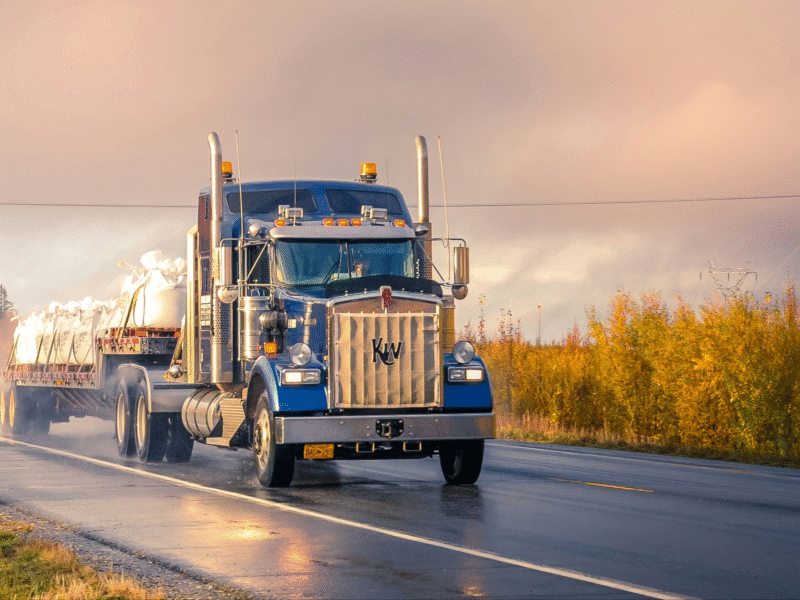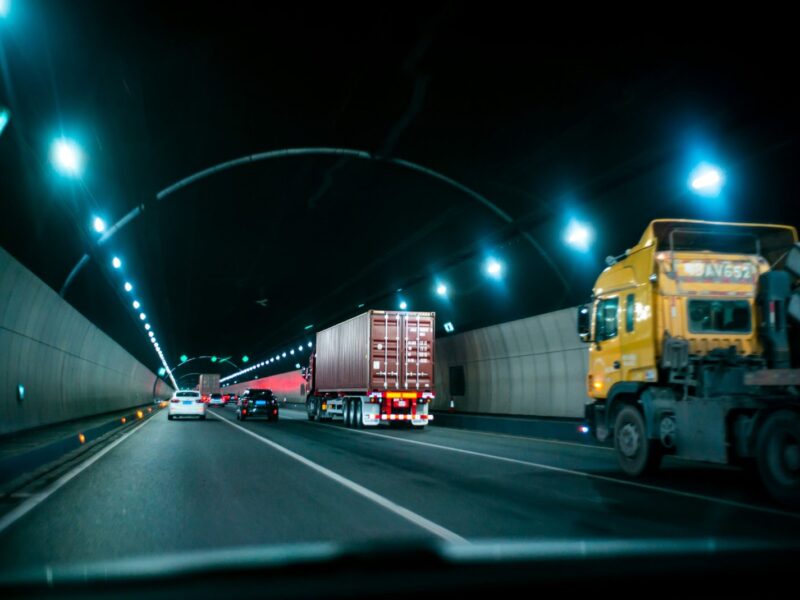Innovations Driving the Future of Dry Van Trucking
Revolutionizing the dry van trucking industry, the integration of IoT sensors and telematics systems is a game-changer, providing real-time data that empowers fleets with unparalleled operational efficiency. A pioneer in this space, KeepTruckin’s Smart Load Board leverages AI to optimize freight matching, reducing empty miles by 15%. Furthermore, predictive maintenance is no longer a futuristic concept; companies like Samsara offer sensors that monitor engine health, allowing for proactive repairs and cutting downtime by up to 40%. For more on this, explore what one dry van trucking company is doing https://www.hmdtrucking.com/transportation-services/dry-van-trucking-company/.
Simultaneously, electric dry vans are trending towards sustainability, with Tesla’s Semi promising a 20% reduction in emissions and maintaining a 500-mile range on one charge. Meanwhile, autonomous trucking ceased to be a dream but rather reality: TuSimple pulled off an 80-mile trip without a human driver in 2022, showcasing the potential for round-the-clock operations. These innovations, marked by precise logistics and greener best practices, do not only reshape dry van trucking but also set newer benchmarks across the logistics landscape-a promise of efficiency, sustainability, and increasing automation towards a well-envisioned future.
Advanced Telematics Systems in Dry Vans
- Real-time Data Integration: Telematics platforms, such as Geotab, integrate well with fleet management systems, thus enabling dispatchers to make informed decisions in split seconds based on real-time location, traffic, and weather conditions.
- Fuel efficiency optimization: Industry reports confirm the capability of telematics to improve fuel efficiency by as much as 25%. Systems observe driving behavior and make recommendations for its improvement, such as minimizing unnecessary idling time and route optimization.
- Improved Safety: Companies like Omnitracs use telematics to monitor driver behavior, sending alerts for harsh braking or speeding, which can reduce accident rates by 20%.
- Regulatory Compliance: Telematics systems make it easier to comply with regulations such as the ELD mandate, automating hours-of-service tracking and reducing paperwork by 85%.
The Rise of Autonomous Trucks: A Game Changer
Autonomous trucks are completely upending dry van trucking, bringing unparalleled efficiencies and changing the paradigm of drivers. In 2023, companies like Embark Trucking and Waymo lead a charge of Level 4 development-capable vehicles to operate with no human intervention on specific routes of operation. In fact, a recent report from McKinsey estimated that by 2027, autonomous trucks could save the freight industry up to $300 billion annually, mainly because of reduced labor costs and increased fuel efficiency. The precision of the AI-driven system reduces accidents involving human error. The Nvidia Drive platform can process 30 trillion operations per second using AI, hence promising safety in dynamic traffic conditions. Equally, continuous autonomous driving by trucks unhindered by mandatory rest breaks maximizes route efficiency and delivery speed, revolutionizing supply chain dynamics. The consensus: with more autonomous driving sharing the roads, the savings amount to not just money but considerable cuts in carbon footprint, benefits inching even closer to that utopian concept of sustainable trucking.
Better Safety Features Using Real-Time Analytics
- Driver Behaviour Analytics: “For companies using driver-facing dash cameras from California’s Netradyne, AI-run algorithms detect both the degree and frequency of fatigue and/or distractions.” Reduction in those related accidents at an astonishing 25%.
- Real-Time Incident Alerts: With platforms like Fleet Complete, there is instant notification in the case of serious events, thus enabling immediate action to minimize further damage.
- Load Security Tracking: Solutions provided by Sensitech ensure continuous monitoring of cargo for shifts or breaches, thus offering protection against theft and damage.
- Environmental Hazard Detection: Advanced sensors, such as those from Bosch, detect real-time road and weather conditions to advise drivers on optimal safety practices.
Eco-Friendly Technologies Reducing Emissions
Eco-friendly technologies have started to reduce emissions in the dry van trucking industry and are highly changing its environmental footprint. Key improvements include the shift toward hybrid and electric refrigeration units-50% more fuel-efficient than their diesel counterparts. The change is being led by companies such as Thermo King, deploying lithium-ion batteries to run refrigeration independently and reduce emissions. Another area of interest is in aerodynamic improvements, including SmartTruck’s TopKit Aero System, which is said to provide a 10% improvement in fuel efficiency through drag reduction. Besides that, the use of biodiesel mixtures, for example, B20, is becoming commonplace and reduces CO2 emissions by about 15%. As these technologies continue to evolve, dry van trucking stands in a position to take the lead with sustainable logistics.
Blockchain Solutions for Efficient Freight Management
Blockchain technology in the business of dry van trucking creates better transparency, security, and efficiency. All the information for any transaction or movement in the supply chain is kept on a decentralized, tamper-proof ledger via blockchain to ensure traceability and responsibility throughout the supply chain. For instance, Maersk and IBM introduced TradeLens, a blockchain-based platform that allows real-time access to shipping data, reducing discrepancies and transactional errors directly by up to 70%.
By utilizing smart contracts — pre-programmed protocols that automatically execute and enforce contractual conditions — blockchain eliminates the need for intermediaries, significantly cutting administrative costs. Additionally, these contracts streamline payment processes, ensuring that stakeholders are compensated promptly upon fulfillment of agreed terms.
Moreover, blockchain’s immutable data records bolster security by mitigating risks of fraud and cargo theft. A report by Transparency Market Research says adoption of blockchain in logistics will surge at a CAGR of 54.5% during the period of 2021 to 2031. Such rapid growth underlines its prospect for making freight management a far more efficient and trusted domain. By embedding blockchain solutions, dry van trucking companies will have the capability of delivering a whole new degree of control and accuracy that is benchmarking standards anew in logistics.
The Impact of 5G on Connectivity and Operations
- Enhanced Fleet Management: With 5G, dispatchers will be able to monitor the location of fleets, health of vehicles, and performance of drivers in real-time for better route optimization and quicker decision-making.
- Improved Safety Features: Advanced cameras and sensors, together with instant data upload capability, offer augmented reality views of possible hazards to drivers and improve safety by as much as 30%.
- Remote Diagnostics and Maintenance: Fleet managers will be able to run diagnostics from a distance and perform software updates with zero downtime, shaving about 20% off the maintenance costs.
- Integration of AI and machine learning: with 5G deployment enabling artificial intelligence-driven analytics that provide comprehensive insights into consumption patterns and predict when maintenance could be required, is a way of improving fuel efficiency effectively by around 15%.
Smart Load Optimization: Maximising The Cargo Space

The innovative intelligent technologies regarding cargo-space are changing the scene in dry van trucking. First, predictive load technologies at Loadsmart apply AI algorithms to the analysis of freight dimensions, weight distribution, and route data for optimal space utilization. It is reported that good load planning can increase cargo capacity by up to 30%, drastically reducing fuel consumption since less space translates to fewer trips. Besides, Cargomatic has developed dynamic load sharing, which applies blockchain for real-time load sharing among carriers to minimize empty space. These advancements not only smoothen operations but also reduce carbon footprints, hence sustainable solutions. By maximizing cargo space, trucking companies can save a fortune in costs, amplify efficiency, and meet pressing environmental standards.
Predictive Maintenance: Reducing Downtime
Predictive maintenance in dry van trucking involves the use of data analytics and machine learning to anticipate vehicle breakdowns before they actually happen, greatly reducing unplanned downtime. By leveraging the power of advanced sensor data through telematics, trucking companies like Convoy are able to identify needs with uncanny accuracy. For example, the predictive model at Convoy has reduced breakdown incidents by 30%, further exemplifying tangible benefits from this innovation.
These predictive systems analyze huge datasets on engine temperature, oil levels, and brake wear patterns to provide the fleet manager with comprehensive health overviews of their vehicles. This proactive approach enables maintenance scheduling during planned downtime, minimizing disruptions. According to a Deloitte study, predictive maintenance can lower maintenance costs by up to 25% and extend the vehicle’s lifespan by 20%.
Companies already using predictive maintenance also report increased driver satisfaction since the trucks are more reliable and safer, thereby causing fewer on-road hiccups. As predictive maintenance solutions deploy, dry van fleets are able not only to optimize operational efficiency but also drive up overall profitability and service reliability-the new benchmark in setting a standard of comparison within the industry.
Road Ahead: Future Trends and Final Thoughts
The future of dry van trucking is very clear: it’s on the cusp of disruptive change, powered by technology advancement and sustainability imperatives. This has already manifested itself in changes at the fleet-management level with greater operational efficiencies made possible, enabled through real-time insights from IoT sensors and telematics installations. Innovations like the Smart Load Board by KeepTruckin and predictive maintenance solutions by Samsara have cut unproductive miles and downtime, setting a new bar for operational precision.
Electric and autonomous vehicles represent the green and efficient future. Tesla’s Semi and the autonomous trucking experiments by TuSimple promise not only to reduce emissions and operate round the clock but also constitute a tectonic shift in how transportation logistics will be envisioned.
Moreover, blockchain technology is redesigning freight management for unparalleled transparency and security, while 5G will further improve fleet operations with much faster and more real-time data exchange. Smart techniques of load optimization also enhance the efficiency of space utilization for cost and environmental benefits.
Further innovations in these fields assure a future in which dry van trucking will rewrite the rules of logistics: unprecedentedly efficient, greener, and technologically sophisticated. Embracing such advancements is going to be pivotal for industry players as they make their way forward.


